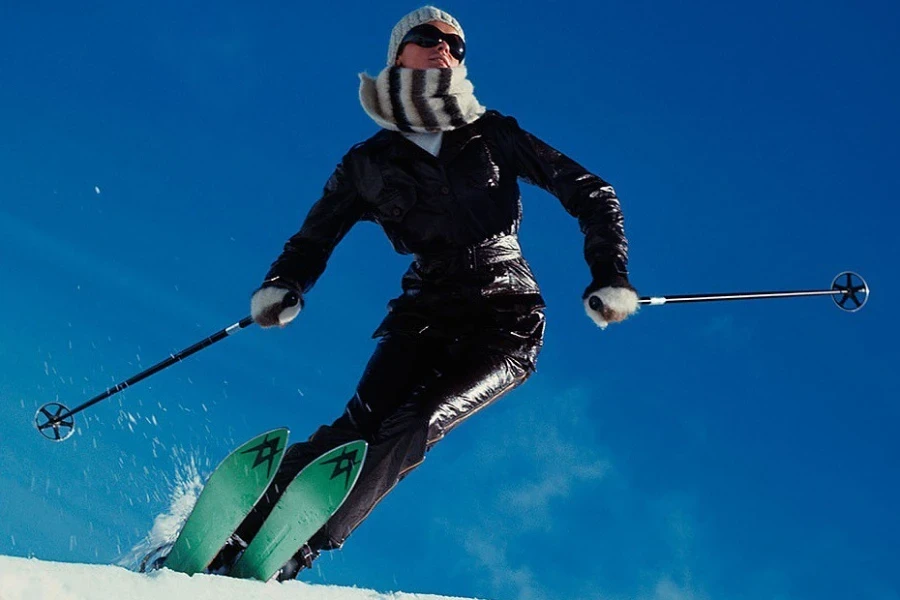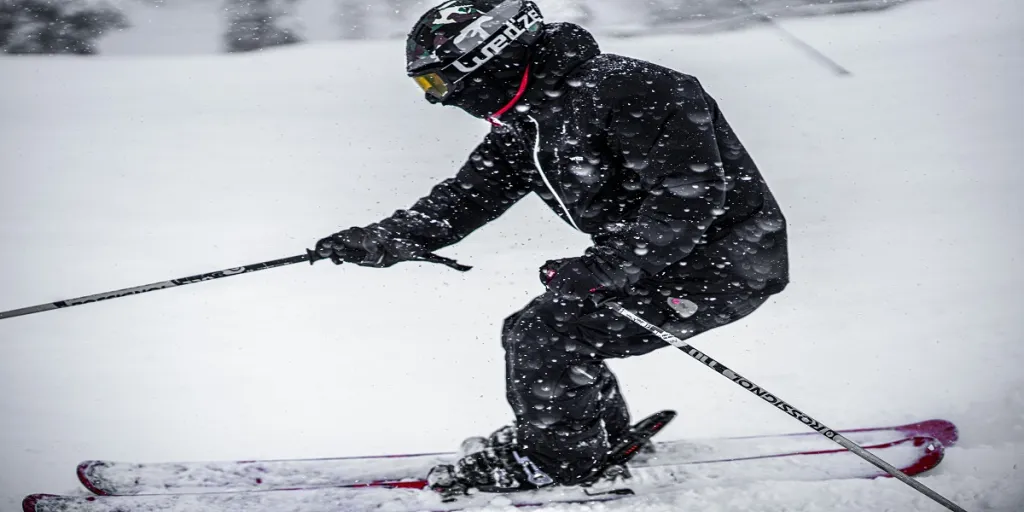The basic ski setup includes a simple combination of bindings, boots, and poles. Rather than being sticks to help keep skiers upright, poles are an important piece of kit that allows them to maneuver on slopes. Choosing the right one can therefore be the difference between a good performance or injury – businesses must then consider their options widely before stocking up.
That’s why we’ve created this guide, providing an overview of six factors businesses must weigh up when entering the ski pole market in 2024.
Table of Contents
What’s the purpose of ski poles?
What will the ski pole market look like in 2024?
6 things worth considering to profit from ski poles in 2024
Conclusion
What’s the purpose of ski poles?
Skiers rely on their poles for two primary functions: mobility and balance. Sometimes, gravity alone isn’t enough to get skiers where they need to go on the slopes; from fabric-covered catwalks to flat pistes, they occasionally require extra push.
But that’s not all. Ski poles also help skiers maintain balance while in action, with pole planting being a necessary part of a correct skiing technique. Ski poles therefore help skiers maintain both balance and rhythm, making them an essential part of optimal performance.
What will the ski pole market look like in 2024?
Experts valued the global ski pole market at US $126.4 million in 2022 and predict it will grow at a CAGR of 3.7% to be worth US $182.6 by 2032 .
Reports show that ski poles make up 10% of the global ski equipment and gear market, which continues to witness an upward trend due to the rising number of people practicing different skiing techniques.
Europe holds the highest share in the market, largely in part to countries like Germany, France, and Switzerland boasting the most number of regular skiers.
6 things worth considering to profit from ski poles in 2024
Ski pole size
Users and businesses can use various methods to measure the ski pole sizes they need. For example,, they can refer to sizing tables like the one below to get the right fit:
| Skier height (in) | Pole length (cm) | Pole length (in) |
| <3’4” | 32 and below | 80 and below |
| 3’9” to 4’0” | 34 | 90 |
| 4’1” to 4’4” | 38 | 95 |
| 4’5” to 4’8” | 40 | 100 |
| 4’9” to 5’0” | 42 | 105 |
| 5’1” to 5’3” | 44 | 110 |
| 5’4” to 5’6” | 46 | 115 |
| 5’7” to 5’9” | 48 | 120 |
| 5’10” to 6’0” | 50 | 125 |
| 6’1” to 6’3” | 52 | 130 |
| 6’4” to 6’6” | 54 | 135 |
| >6’7” | 56 | 140 |
Shorter poles may be harder to plant correctly, affecting the user’s ability to turn, while longer poles can interfere with the user’s technique, affecting skiing ability and enjoyability.
Terrain type
Novice skiers don’t need many ski pole variations – the basic sizes will likely suffice. However, things get more advanced with intermediate to expert skiers. They’ll often ski on more challenging terrains and require more advanced ski poles to attain maximum performance.
For instance, park or pipe skiers need shorter poles for the best experience. Since poles often come in 2” size differences, businesses may want to also offer downsized variants (smaller by one size). This can help them to avoid knocking their poles on park obstacles or halfpipe walls.
Powder and backcountry skiers also require shorter poles than standard alpine variants, since the last thing they want is to hit their poles on trees and rocks.
However, consumers who prefer skiing on mountain trails are likely to stick to standard alpine poles. From bombing blue runs to on-piste steeps, these ski poles offer the most versatility across any mountain.
Touring skiers, meanwhile, often need longer poles to propel them while ascending slopes. However, the extra length may obstruct them from descending. The solution? Businesses can offer adjustable poles that can easily transition from short to long and vice versa.
Lastly, racers are a different breed. They need something entirely different from standard alpine poles, as they covet aerodynamics and speed over everything else. Hence, racer ski poles are typically lightweight and curved.
Pole material
Ski poles are traditionally made from one of three different materials: carbon, aluminum, or a composite.
Businesses will want to weigh up a few factors before they stock up.
Carbon ski poles will mostly appeal to consumers with a higher budget and are looking for higher quality poles. This material is light, strong, and flexible, so ski poles made from it are often very durable and narrower than other variants.
On the other hand, aluminum poles are more affordable, while also being popular for their durability and strength.
Composite ski poles don’t use one material – they are a mix of metals and plastics. As a result, they often have better performance than both aluminum or carbon variants on specific terrains, especially backcountry or hard snow. In addition, most composite ski poles offer improved shock absorption.
Grip
Although ski pole grips vary, which a user chooses will usually depend on whether they wear gloves or mittens. Grips with smooth surfaces are easier for skiers who wear mittens (such as park skiers) to hold and complete tricks. But skiers who wear gloves require molded grips to better hold the pole securely.
Businesses can choose between four grip types for ski poles. Below is an overview of the four varieties and who they’re suited for:
| Grip type | Ideal user |
| Rubber grip | Beginner to intermediate skiers Wet or varying weather conditions Skiers who prefer a comfortable, grippy feel Budget-conscious skiers |
| Cork grip | Intermediate to advanced skiers Skiers who prioritize natural materials Skiers who want a soft, moisture-wicking grip Skiers looking for good insulation in cold weather |
| Foam grip | Backcountry and touring skiers Skiers seeking lightweight and comfortable grips Consumers who need insulating properties in colder temperatures Cross-country and Nordic skiers |
| Plastic grip | Recreational and rental skiers Consumers searching for affordable but durable options Skiers in areas with mild climate conditions |
Pole straps

While ski pole straps become increasingly high-tech, most still feature loops, which help keep users close in case of a fall. They also help aid functionality on the slope, while providing enough flexibility to allow users to remove them easily to ride chairlifts, etc.
Some advanced ski pole straps feature clickable designs and may also have quick-release capabilities. These features are handy for backcountry skiers or racers, especially in the event of a fall.
Below we take a look at the different types of straps that can adopt a loop, clickable, or quick-release styles:
| Ski pole strap | Suitable skiers |
| Standard wrist straps | Beginner and recreational skiers Skiers who prefer basic, no-frills straps Consumers on a budget |
| Adjustable wrist straps | Intermediate to advanced skiers who desire a customizable strap length Consumers looking to fine-tune their pole control |
| Padded wrist straps | Backcountry and touring skiers Consumers who spend a lot of time on the slopes Skiers with hand or wrist issues Customers who prioritize comfort and support |
| Racing hand straps | Alpine racing and high-performance skiers Skiers seeking maximum power transfer Consumers who need quick release and secure fit |
Note: Freestyle and terrain park skiers may prefer strapless ski poles, providing them unrestricted pole movement
Ski pole baskets
Baskets impact the ski pole’s performance. Although they all serve the same function – stopping the pole from entering deep into the snow – their size will depend on the skier type and terrain.
Alpine and downhill skiers need poles with small baskets as the slopes they ski on will most likely have shallow snow. In addition, smaller baskets help to reduce weight and allow lighter slope movement.
Conversely, powder skiers often opt for poles with wider baskets. Powdered slopes often feature deep fluffs, requiring more basket surface area to stop the pole from penetrating deep into the powder.
Lastly, racers typically prefer poles with very small baskets. As mentioned earlier, ski racing is all about aerodynamics, and small baskets mean less drag.
Conclusion
Ski poles are an important part of a skier’s gear, so it’s necessary for businesses to stock a range of sizes for their consumers based on target terrain and style.
Retailers must also consider their target consumer’s budget and desired terrain to know what best to offer. Finally, make sure not to overlook the components of ski poles, namely, their grip, strap, and basket.
Once sellers factor in all these considerations, it will be easier to pinpoint the most profitable ski poles to invest in for more sales in 2024.
If you’re looking to stock up on the latest ski poles on the market, browse thousands of options on Alibaba.com today.




